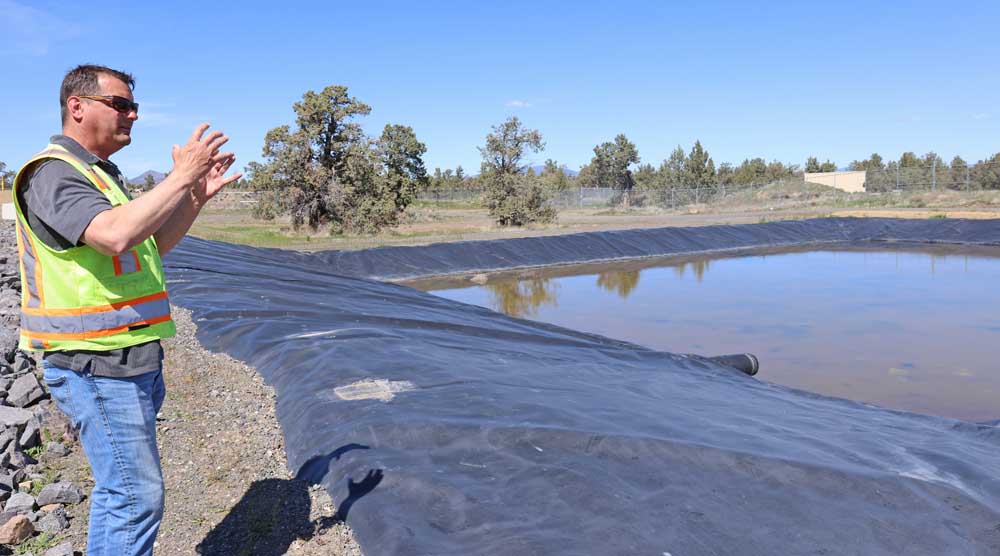Deschutes County makes Negus Transfer Station environmentally friendly
Published 5:45 am Friday, May 10, 2024

- Jeff Merwin, compliance and infrastructure manager with the Deschutes County Department of Solid Waste, describes the leachate pond at the new Negus Transfer Station in Redmond. The pond is lined with 31,200 square feet of geomembrane specially designed to capture contaminated runoff from trash and then naturally evaporate clean water into the atmosphere.
REDMOND — Driving up to the remodeled Negus Transfer Station in Redmond, it’s easy to focus only on the new indoor dumping facility. It’s shiny and monumental in size with state of the art scales and mechanical safety features that dazzle.
But there’s more to this renovation.
Trending
Set unobtrusively off to the right side of the road are two new ponds. The larger, is a rainwater collection basin already sprouting with native flora. The other, called a leachate pond, is lined with 31,200 square feet of geomembrane specially designed to capture contaminated runoff from trash and then naturally evaporate clean water into the atmosphere.
You see, trash is wet, and wet trash contains contaminants. So even though all the waste brought to the transfer station eventually finds its way to Knott Landfill via transfer trucks, there is still an opportunity for contaminants to seep into the soil.
Until now, when the county decided to add the leachate pond, despite it not being a federal or state requirement for the facility.
“People think they give us solid waste and we’re just burying all the trash, but we are actually environmentalists first … There was not necessarily a requirement for it, but we wanted to go ahead and pay the extra money to limit our liability to contamination,” said Jeff Merwin, the compliance and infrastructure manager for the Deschutes County Solid Waste Department.
How leachate pond work
The leachate pond at Negus Transfer Station works through evaporation. Any moisture left behind by items dumped at the transfer station drains from the concrete floor into an oil separator.
Trending
From there, it’s directed to the leachate pond where water naturally evaporates from the contaminated liquid.
Merwin said the types of contaminants vary, but usually they come in the form of hazardous items — like paint, fertilizer, and cleaning products — that accidentally make their way into the transfer station despite being prohibited.
“You’re at the mercy of what the public brings in … so you could get some materials in there that shouldn’t be. We try to screen and we have inspections, but it can happen. It does happen. It’s very low risk even if we didn’t have a leachate system, but this just ensures that we won’t have any problems,” Merwin told The Bulletin.
The pond is very low-maintenance, Merwin said. The leachate only needs to be drained and cleaned once every 20 years. Occasionally, stray litter will land in the pond, but that just means staff will need to fish it out with a net. Otherwise, the pond is self-sustaining.
Other eco-friendly solutions
The leachate pond wasn’t the only environmental enhancement made to Negus Transfer Station during its $20 million makeover. Tim Brownell, the director of solid waste, said the skylights are his favorite feature at the new facility.
“We have fantastic light in here … (The skylights) are going to allow us to reduce our use of both LED and other lighting, so it’s going to be more energy efficient,” Brownell said.
Another environmental consideration was the landscaping, which Merwin said was a challenge because the property is so large. It also operates on a domestic well, meaning the transfer station can only produce a limited amount of water each day.
The solution management came up with was to select native plants that will help prevent erosion but will ultimately require less water as they become more established. As time goes on, less and less water will be delivered to the plants, and then only at night when evaporation is at its lowest.
Overall, Merwin said he is happy everything came together so well with the new facility at Negus Transfer Station. And the leachate pond just makes everything safer.
“People don’t realize that transfer stations do create leachate, and we don’t want that going into the groundwater, period … I’m happy we could do this for the community. It’s about 15 years overdue,” he said.








